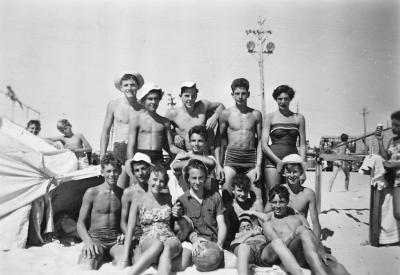PHOTOGRAPH (DIGITAL): AUSTRALIAN FINE CHINA FACTORY, 2006
2006Coloured photograph of workers and the interior of the factory at Australian Fine China. Image shows two men cooking at a BBQ inside the factory. One man in glasses and a blue sweat shirt is looking at the camera and holding a fork over the steaks on the BBQ. The other man is chopping onions on the hot plate. In the background is a table with plastic cups, paper napkins, and salt and pepper. There are louvered windows in the background and a power board.
In 1921, Calyx Porcelain and Paint Company Ltd. became the first company in Western Australia to produce ceramics. Under various ownership, by the 1950s the business had progressed to become the “Largest potteries in Australia “. The kilns and factories, located in the Perth suburb of Subiaco were demolished in 2006; making way for new residential and commercial buildings.
In the beginning, skilled craftsmen were brought from the U.K. They used locally sourced raw materials; clay from Goomalling and Kalamunda, sand from Lake Gnangara and feldspar from Coolgardie and began producing a wide range of earthenware and china. Many challenges led the company into voluntary liquidation in 1925 and becoming an asset of the WA Government in early 1926.
A Calyx Porcelain Co Ltd. catalogue and price list from circa 1926 offers “Semi Porcelain DINNER WARE, BREAKFAST WARE, TEA WARE, TOILET WARE, KITCHEN WARE, and Sundries.”
Over the Calyx period 1921 to 1941 and in addition to the utilitarian wares, the factory produced fine and uniquely beautiful pieces that are highly valued, highly collectable and highly priced today. In fact, all Calyx Ware is desirable to the collector or investor.
The factory struggled on under three different managers and through the difficult global economic times of the war years. With Government benevolence it survived and in March 1941, “Mr HL Brisbane wrote to the WA Ministry for Industries suggesting that his firm take an option for the purchase of the works.”
HL Brisbane and Wunderlich Ltd first leased and then purchased the Calyx Porcelain Works in 1945, changing the name of the Subiaco based porcelain division of the business to Bristile China.
Between 1945 and 1950 the factory underwent modernization and expansion and by 1953 was in full production. At a time of recovery from WW2, a buoyant economy and happy consumers, a new product line was introduced. This ‘Fancy Ware Range’, called Wembley Ware, became “Australia’s largest range of commercially-produced ceramics” in the 1950s. Wembley Ware was produced from 1946 to 1961 and was sold nationally and in New Zealand.
To avoid tax, Wembley Ware’s highly crafted, lustred and decorated pieces also had a practical use being ashtrays, vases and kitchen ware. Other novelty Wembley Ware with a useful purpose includes bookends, shaving mugs and card holders. A small amount of bone china was also produced and these pieces are highly prized by collectors.
George Clausen is credited as the “man behind the ideas, giving encouragement to the modellers and artists” producing Wembley Ware. Among the artisans, John Tribe (1904 – 1974) was responsible for many of the better quality pieces and Ruby Neevay (1925 – 2012) a ceramic artist who began her employment with Brisbane and Wunderlich at the age of 15 years.
1992 saw “ownership of the parent company Bristile Ltd changed to Futuris Ltd” and a “change of name to Australian Fine China.” However, time was running out for this iconic Western Australian ceramic production site and in 2006, after 85 years, it was all over. Ironically, Australian Fine China is now made in China.
Details
Details
Photograph taken at the Australian Fine China Factory just prior to it closing.
More items like this
Other items from Subiaco Museum
- PHOTOGRAPH (DIGITAL): AUSTRALIAN FINE CHINA FACTORY, 2006
- PHOTOGRAPH (DIGITAL): AUSTRALIAN FINE CHINA FACTORY, 2006
- PHOTOGRAPH (DIGITAL): AUSTRALIAN FINE CHINA FACTORY, 2006
- PHOTOGRAPH (DIGITAL): AUSTRALIAN FINE CHINA FACTORY, 2006
- PHOTOGRAPH (DIGITAL): AUSTRALIAN FINE CHINA FACTORY, 2005
- PHOTOGRAPH (DIGITAL): AUSTRALIAN FINE CHINA FACTORY, 2006
- PHOTOGRAPH (DIGITAL): AUSTRALIAN FINE CHINA FACTORY, 2005
- PHOTOGRAPH (DIGITAL): AUSTRALIAN FINE CHINA FACTORY, 2006
- PHOTOGRAPH (DIGITAL): AUSTRALIAN FINE CHINA FACTORY, 2006
- PHOTOGRAPH (DIGITAL): AUSTRALIAN FINE CHINA FACTORY, 2006
- PHOTOGRAPH (DIGITAL): AUSTRALIAN FINE CHINA FACTORY, 2006
- PHOTOGRAPH (DIGITAL): SUBIACO TEENAGERS ENJOYING AN OUTING TO THE BEACH, LATE 1950S

